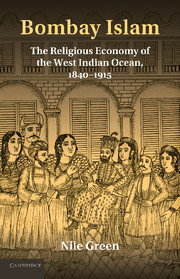Book contents
- Frontmatter
- Contents
- Illustrations
- Acknowledgements
- Maps
- Introduction
- 1 Missionaries and Reformists in the Market of Islams
- 2 Cosmopolitan Cults and the Economy of Miracles
- 3 The Enchantment of Industrial Communications
- 4 Exports for an Iranian Marketplace
- 5 The Making of a Neo-Ismā‘īlism
- 6 A Theology for the Mills and Dockyards
- 7 Bombay Islam in the Ocean's Southern City
- Conclusions
- Notes
- Bibliography
- Index
5 - The Making of a Neo-Ismā‘īlism
Published online by Cambridge University Press: 03 May 2011
- Frontmatter
- Contents
- Illustrations
- Acknowledgements
- Maps
- Introduction
- 1 Missionaries and Reformists in the Market of Islams
- 2 Cosmopolitan Cults and the Economy of Miracles
- 3 The Enchantment of Industrial Communications
- 4 Exports for an Iranian Marketplace
- 5 The Making of a Neo-Ismā‘īlism
- 6 A Theology for the Mills and Dockyards
- 7 Bombay Islam in the Ocean's Southern City
- Conclusions
- Notes
- Bibliography
- Index
Summary
THE ĀGHĀ KHĀNS AND THEIR NEO-ISMĀ‘ĪLISM
Among the many Iranian exiles attracted to Bombay was the most important figure to leave Iran for India during the nineteenth century. This was the would-be leader of the disconnected Ismā‘īlī Shi‘i Muslims of India and Iran: Āghā Khān I (d. 1298/1881) of Mahallat in central Iran. Before moving into exile in India, Āghā Khān I had served Iran's Qājār rulers as governor of the southern frontier province of Kerman, and was more widely regarded as a provincial notable and soldier than a religious figure. The last chapter showed how Iranian Sufis such as Safī ‘Alī Shāh, sponsored by the wealthy Iranian merchants who settled in Bombay and making use of the city's printing and travel opportunities to spread their authority, were able to use Bombay as a platform for their extraordinary leap to prominence in Iran in the second half of the nineteenth century. By similar means, after settling in Bombay in 1848, Āghā Khān I was able to use the city's communication, mercantile and administrative facilities to expand his authority over nominal Ismā‘īlīs to a degree without precedent in history. As with Sufi entrepreneurs, in the career of the Āghā Khān and his sons and successors, Bombay's religious economy was put to the service of an expansive mission for an Islam of living intercessors and the miraculous powers lent them by their proximity to God.
- Type
- Chapter
- Information
- Bombay IslamThe Religious Economy of the West Indian Ocean, 1840–1915, pp. 155 - 178Publisher: Cambridge University PressPrint publication year: 2011
- 1
- Cited by



